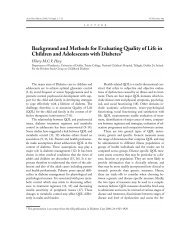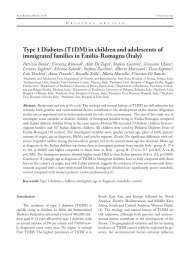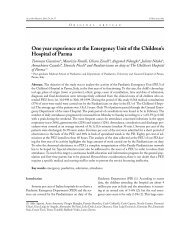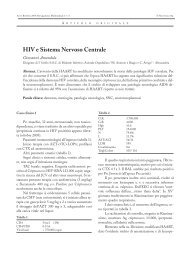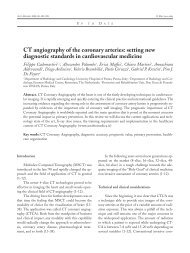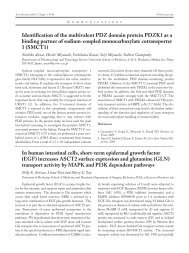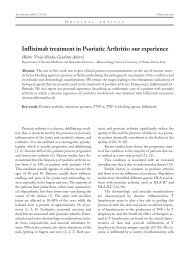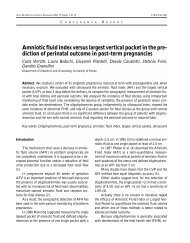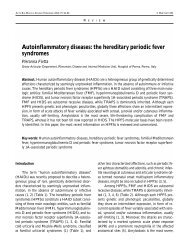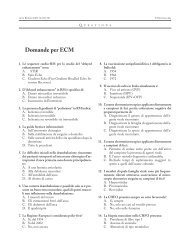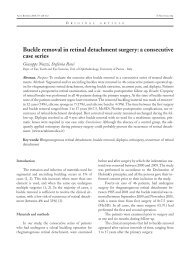Mattioli - Acta Bio Medica Atenei Parmensis
Mattioli - Acta Bio Medica Atenei Parmensis
Mattioli - Acta Bio Medica Atenei Parmensis
You also want an ePaper? Increase the reach of your titles
YUMPU automatically turns print PDFs into web optimized ePapers that Google loves.
ACTA BIOMED 2006; 77; 33-39 © <strong>Mattioli</strong> 1885<br />
U P T O D A T E<br />
Self-centrality, psychosis and schizotaxia: a conceptual<br />
review<br />
Andrea Raballo 1, 2 , Eva Lundgren 2 , Emanuela Leuci 3 , Stefania Fontò 2 , Carlo Maggini 2<br />
1<br />
Psychiatric Intensive Care Unit, Department of Mental Health - AUSL Reggio Emilia; 2 Department of Neurosciences, Psychiatric<br />
Section, University of Parma, 3 Azienda Ospedaliera Desenzano D/G, Brescia<br />
Abstract. The phenomenon of self-centrality denotes a qualitative modification of the psychotic experience.<br />
Transitory experiences of self-reference have regularly been found in subjects in the prodromic phase and at<br />
the beginning of psychosis or in the post psychotic phase, and are specifically identified in the semeiotics of<br />
Basic Symptoms. However, self-centrality, in addition to being a morphological organizer in the psychotic<br />
crisis, also manifests itself in schizotypal personality disorders and in first-degree relatives of schizophrenics<br />
(where it is correlated to the degree of schizotypal traits). In these subjects, manifestations of self-centrality<br />
of a lesser intensity could be an indication of a latent vulnerability trait, which could modulate personal<br />
and psychopathological expressions of the schizotaxic diathesis. (www.actabiomedica.it)<br />
Key words: Self-centrality, subjective experience, beginning psychosis, schizophrenia spectrum, schizotaxia,<br />
vulnerability<br />
Introduction<br />
Autocentric-like experiences, which often include<br />
self-reference, have been described and contextualized<br />
in relation to the psychopathology of psychosis<br />
by Bleuler (Beziehungswahn) (1), and by Kretschmer<br />
(delusion of sensory relation, which brings about a<br />
“paranoid transformation of personal experience”) (2).<br />
Later, the same was done by Schneider who, along<br />
with Jaspers and Gruhle, pointed out that in the context<br />
of delusional perception the emergence of abnormal<br />
meaning occurs “generally in a sense of self-centrality”<br />
(3, 4). Next, Binswanger coined the prototypical<br />
notion of “being placed in the center” as a crucial<br />
turning point where the passage from a natural experience<br />
to a delusional one takes place (Ilse’s case) (5).<br />
Nevertheless, a description more specifically geared<br />
towards a characterization of the formal peculiarities<br />
of psychotic onset was originally put forth by Conrad,<br />
and later, in the French psychopathological literature,<br />
by Grivois.<br />
“Incoherence, polymorphism, loss of sense”, is the<br />
way that Sirere, Naudin and Grivois (6) sum up the<br />
clinical phenomena of the inaugural psychotic experience,<br />
stressing subjective experiences as a unifying<br />
factor. Among such subjective experiences, “centrality”<br />
could be a useful starting point when attempting to<br />
outline certain types of organizers which are part of<br />
the acute onset of psychosis.<br />
Accordingly, in Die beginnende Schizophrenie (7),<br />
Klaus Conrad outlines a detailed analysis of the phenomenological<br />
stages of the onset and development of<br />
psychotic consciousness, stressing the psychopathological<br />
importance of the gestaltic change in elemental<br />
ways of experiencing (8).<br />
In fact, Conrad points out that in the experience<br />
of the abnormal, attribution of meaning (apophany),<br />
and the consistent impression of being at the center of<br />
the “world” (anastrophe) are the “two elements characteristic<br />
of the structural mutation of the schizophrenic<br />
experience” and are “immediately and reciprocally<br />
related”. Anastrophe, in particular, would attest to
34 A. Raballo, E. Lundgren, E. Leuci, S. Fontò, C. Maggini<br />
“an extremely altered capacity to change systems of reference”,<br />
which results in a “loss of degrees of positional<br />
freedom”. The ability to “freely change reference<br />
systems” is, according to Conrad, the foundation of<br />
interpersonal attunement and hence represents the<br />
spontaneous ability of each person, albeit living in the<br />
center of his or her “world” to see themselves from<br />
“the outside”, “from above”, “from a bird’s eye view”,<br />
(and to) relate their own “world” to that general world<br />
of others” (7).<br />
“In his state of psychosis”, Conrad continues,<br />
“the schizophrenic has lost this possibility of transcendence<br />
…no matter what he looks at and no matter in<br />
what direction the arrow of his intent is aimed, that<br />
object “relates to him”.<br />
The impossibility to change perspective already<br />
comes to the surface in the Trema phase, where “the impossibility<br />
of transcendence is experienced as a barrier”<br />
and the entire psychic field is permeated with an imminent<br />
and undefinable state of alarm. This experience<br />
evolves into apophany (characterized by the total<br />
unfolding of the anthropological device of revelation)<br />
and into anastrophe (characterized by the slipping into<br />
a diffuse and impending erlebnis of self-reference), which<br />
may, however, subside if it does not crystallize and<br />
permit a return of the ability to decentralize oneself.<br />
According to Grivois (9), centrality (represented<br />
by an erroneous self-attribution of the intentions,<br />
judgments or behaviors of others) can be viewed as a<br />
clinical constant in beginning psychosis. The birth of<br />
psychosis resides in the crisis of interpersonal relationships<br />
which results in an abnormal conviction of being<br />
a focal point at the center of the world. “Centrality”,<br />
Grivois states, “is due to a collapse of subjectivity which<br />
derives from an insecurity in the relationship with<br />
others.” (10).<br />
At first, the experience is purely perceptive and<br />
mimetical, without any threatening significance, only<br />
to become a “specific emotion which intensifies” so<br />
that the most insignificant and marginal interactions<br />
and exchanges become signs that allude to the subject<br />
in question.<br />
Next, the process evolves into a general “alteration<br />
of interindividuality” (centralité) which modifies, “at times<br />
in a striking way”, the experience of being a man<br />
in a social context. “The individual feels as if he is at<br />
the center of reality to the point that everything that<br />
happens on a mundane level is related to him” (11).<br />
In a recent conceptual revision, Sirene, Grivois e<br />
Naudin (4, 6) have proposed an anthropophenomenological<br />
interpretation of centrality as a “fourth form of<br />
missing existence“ subsidiary to the triptych of Binswanger<br />
(“fixed exhilaration”, “eccentricity”, “mannerism”).<br />
The concept of centralité, in fact, constitutes a<br />
breach in the relationship between the amplitude of<br />
experience and the capacity to elaborate, which constitutes<br />
the anthropological proportion and provokes a<br />
profound spatial distortion of inter-personal orientation.<br />
It is the specific notion of centralité as a “forme de<br />
la Présence manquée” which accounts for its perseverance<br />
in the pre- (12-14) and post-psychotic phase<br />
(15-17), where the self-centered approach is the favored<br />
medium in “enduring earthly existence each time<br />
that the patient experiences a conflictual situation that<br />
he or she does not know how to manage” (18).<br />
Self-centrality and the Basic Symptoms Model 1<br />
The dynamic pathogenetic models of Huber<br />
(transitions between various Basic Symptoms) (19,<br />
20) and Klosterkoetter (serial connection) (21), within<br />
the context of “understanding” according to Jaspers,<br />
allow for a stimulating psychopathological revision of<br />
beginning psychosis. Within this conceptual framework,<br />
it is possible to redefine the self-centered experience<br />
into phenomenologically unitarian sequences.<br />
The latter guide the elaboration of overt productive<br />
symptoms and, contemporaneously, allow for a refined<br />
clinical discrimination between delusional selfcentrality<br />
(ie. apophanic Self-Centrality) and a more<br />
preliminary, subtle and elusive form, that is, subapophanic<br />
self-centrality, (16, 17) (in which the Copernican<br />
turning point can still be reached).<br />
1<br />
The concept of “Basic Symptoms” is clinically based on: basic<br />
experiences, uncharacteristic and aspecific, lived as a disturbance,<br />
and confined to the subjective sphere (19,20). Technically,<br />
Basic Symptoms indicate a personal perception of a deficit<br />
in drive, emotions, perception, interaction, thought, language,<br />
and planning activities, and can be qualified using the<br />
Bonn Scale for the Assessment of Basic Symptoms (22) [BSABS].
Self-Centrality, Psychosis and Schizotaxia<br />
35<br />
This basal self-centrality, which is included in the<br />
Bonn Scale for the Assessment of Basic Symptoms 2<br />
(22), denotes the fundamental precariousness of the<br />
ability to transcend on a primarily prereflective and<br />
protopathic level, and is probably due to the intervention<br />
of transphenomenic neurofunctional mechanisms<br />
(10, 11, 22, 23).<br />
Indeed, the self-centered experience is a paradigm<br />
of disturbed intersubjectivity which subsumes<br />
the preservation of the “ability to transcend” (Überstiegsfähigkeit)<br />
as a precondition for the intuitive establishment<br />
of “vital attunement” with the environment<br />
(24). In particular, if the psychotic condition also includes<br />
a pathology of intersubjective competence, the<br />
disturbance of the ability of attunement involved in<br />
self-centrality (especially when subapophanic in nature<br />
as described by the Basic Symptoms model), could<br />
be a psychopathological indicator of psychotic vulnerability<br />
and could modulate the course of the disease.<br />
Already in the “as if ” form, self-centrality reveals<br />
a state of surproximité (25) to the world which impedes<br />
the “ability to reside serenely among things” (26)<br />
and alludes to an underlying autistic vulnerability (27,<br />
28).<br />
Clinical evidence<br />
On the empirical level the relationship between<br />
self-centrality, anomalous subjective experiences<br />
(and/or Basic Symptoms), and psychosis has been examined<br />
using different experimental paradigms.<br />
Onset<br />
A ten-year prospective study (Cologne Early Recognition<br />
Project) performed on a group of subjects<br />
2<br />
The item C1.17 ”Subject-Zentrismus” of the BSABS, explicitely<br />
describes the “Centrality of the Subject” as an “experience<br />
of self-reference perceived and described by the patient who<br />
sees unimportant events, such as the behavior and comments<br />
of others, as being referred to him, even though he realizes at<br />
the same time (or immediately afterwards) that such an event<br />
is impossible or improbable. The patient has the feeling of<br />
being in the center of events without having a concrete or elaborated<br />
sense of such experience (22).<br />
treated in the clinical setting for putative prodromic<br />
symptoms has shown that certain Basic Symptoms,<br />
included in the subsyndrome “thought, perception,<br />
language and motility disturbances,” have a high positive<br />
predictive value in identifying individuals at increased<br />
risk of transition into schizophrenia (79 individuals<br />
out of 160 evaluated). Among these “highly<br />
predictive prodromal symptoms” (HPPS) transitory<br />
ideas of reference experienced in the “as if ” mode are<br />
also included (Item C1.17 of the BSABS: specificity,<br />
0.89; false positives, 5.6%) (29).<br />
More recently the same group performed a<br />
“short term follow-up” which confirms the positive<br />
predictive power of HPPS already after fifteen<br />
months (13, 14).<br />
In addition, the same research team has found<br />
that when comparing the anomalies of subjective experiences<br />
preceding the first schizophrenic and depressive<br />
episode, self-centrality is among the discriminatory<br />
Basic Symptoms (in addition to: feeling<br />
overwhelmed by sensory stimuli, disturbances in auditory<br />
perception, and disturbances in the ability to control<br />
non-verbal expression and affect), indicating that<br />
this combination of Basic Symptoms precedes the onset<br />
of the overt clinical episode by two to seven weeks<br />
(30).<br />
In accordance, the preliminary results of the<br />
EPOS (European Prediction of Psychosis Study)<br />
when analyzing the baseline symptomatology in a High<br />
Risk Sample in Amsterdam, have shown self-centrality<br />
to be present in over three fourths of the<br />
subjects studied (76%) (31).<br />
Postpsychotic phase<br />
Given a series of empirical indications derived<br />
from groups of subjects in the postpsychotic phase, it<br />
is possible to view self-centrality in a more relative<br />
way not only as an elective erlebnis at the onset (or in<br />
the immediate prodromic pre-psychosis), but also as<br />
an expansion of its psychopathological relevance to intercritical<br />
periods characterized by a relative stability<br />
of symptoms (15). In the postpsychotic phase patient,<br />
in fact, the discrimination between apophanic (i.e. delusional)<br />
and subapophanic Self-Centrality is appropriate<br />
in that it allows for the distinction between
36 A. Raballo, E. Lundgren, E. Leuci, S. Fontò, C. Maggini<br />
overt aspects of the psychotic experience, and more<br />
subtle qualitative changes in spatial perception which<br />
are not yet organized in a delusional sense (15, 16).<br />
Transitory impressions of self-reference “with an<br />
immediate ability to reactivate the Copernican turnover”<br />
are recognizable in over two thirds of schizophrenic<br />
subjects in psychotic remission (15). The presence<br />
of self-centrality is associated with a particular psychopathological<br />
profile: greater intensity of xenopathic<br />
content compared to other delusional themes<br />
and higher levels of basal-distress (16). In addition,<br />
self-centrality is strongly correlated to subjective experiences,<br />
such as alexithymia, depersonalization, and<br />
basic obsessions (15).<br />
A re-evaluation of the preliminary results in a wider<br />
sample has confirmed that of the three psychopathological<br />
constellations of greatest pertinence to<br />
sub-apophanic self-centrality (delusions of “controlpersecution”,<br />
alexithymic “difficulty identifying feelings”,<br />
and “abnormal body feelings”), the cenesthesic<br />
Basic Symptoms are those most highly predictive of<br />
its cooccurence (17).<br />
The importance of self-centrality in the characterization<br />
of schizophrenic self-experience is further validated<br />
by a comparative evaluation of Basic Symptoms<br />
in different diagnostic classes: subapophanic<br />
self-centrality increases the discriminative power of<br />
subjective experiential anomalies (32) (designated according<br />
to phenomenological criteria (33) to characterize<br />
core aspects of the schizophrenia spectrum 3 ). This<br />
is the case where affective disorders, as well as obsessive-compulsive<br />
disorders, are concerned indicating<br />
that a consideration of autocentric disturbances of intersubjectivity<br />
could be useful to understand the psychopathological<br />
experience of schizophrenia (17, 23,<br />
32).<br />
3<br />
Included in this reclassification of Basic Symptoms, we find<br />
seven subclassifications which are: Diminished affectivity (global<br />
deflection of affective potential), Disturbed contact (difficulties<br />
and subjective embarassment in social and interpersonal<br />
relationships), Perplexity (altered articulation and intuitive interpretation<br />
of meanings), Cognitive disorder (a reduced flow in<br />
cognitive processes), Self-disorder (a disorder in the experiences<br />
of self ), Coenesthesias (disorders in bodily experiences) and<br />
Perceptual disorder (perceptive distorsions) (33).<br />
Schizotaxic vulnerability<br />
The phenomenon of self-centrality also manifests<br />
itself in subjects with schizotypal personality disorder<br />
and in first-degree relatives of schizophrenics 4 . This<br />
population has a high schizotaxic risk (34-36) and presents<br />
(as has also been found on a neurocognitive and<br />
personality level) a profile of anomalies of subjective<br />
experience which can be collocated midway between<br />
the general population and the conditions typical of<br />
the clinical spectrum (36, 37), with a particular reference<br />
to cognitive and cenesthesic Basic Symptoms<br />
(34). The correlation between such symptoms and the<br />
intensity of schizotypal traits (38) seems to suggest<br />
that an altered experience of physicality and cognitive<br />
proficiency constitute the psychological correlate (35)<br />
of the dimensions of schizotypy (39). Further, it has<br />
been found that sub-apophanic self-centrality is correlated<br />
both to cognitive-perceptual as well as to interpersonal<br />
factors of schizotypy, thus representing a shared<br />
experiential background for both (23).<br />
Additional research, above all in developmental<br />
psychopathology, is necessary to ascertain whether the<br />
predisposition to self-centrality is a prerequisite for<br />
the development of positive and negative traits of the<br />
schizotypy, or whether it is a consequence. However,<br />
it seems plausible (considering the Basic Symptoms<br />
Model (19,20) and the theory of Meehl (35)) that a<br />
common schizotaxic vulnerability provokes a transphenomenological<br />
liability in the intersubjective space.<br />
The latter reverberates on the level of personality in<br />
the interpersonal and cognitive-perceptive dimensions<br />
of the schizotypy, as well as in the experiential one of<br />
transitory experiences of self-reference (23, 37).<br />
Clinical, therapeutic, and diagnostic implications<br />
A careful consideration of the phenomenon of<br />
“central polarization”, both in its more subtle form (“as<br />
4<br />
The cross-sectional “as if ” self-centrality in recently evaluated<br />
samples (34), analyzed in the out-patient clinic of the Psychicatric<br />
Section of the Neurosciences Department of the University<br />
of Parma has shown: control groups [
Self-Centrality, Psychosis and Schizotaxia<br />
37<br />
if ”) and in the overt form, has important clinical consequences<br />
in that it allows for a prediction of the susceptibility<br />
to schizophrenia and psychotic relapse,<br />
thus making possible the formulation of an adequate<br />
observational and therapeutic protocol.<br />
Psychotherapeutic, educational, and psychopharmacological<br />
intervention on Basic Symptoms can arrest<br />
their transition to psychotic symptoms, thus facilitating<br />
the return to less persistent and disturbing<br />
symptoms (first level Basic Symptoms) and avoiding a<br />
stable and autonomous psychosis (20, 21). In this context,<br />
in order to maximize the patient’s coping skills,<br />
the analysis of the experience of self-centrality is a<br />
priority.<br />
On this topic, Grivois and Grosso stress the importance<br />
of a “clinical-relational” approach when treating<br />
beginning psychosis. The doctor and the patient<br />
find themselves auspicably “sharing a perspective of<br />
common intelligence regarding the event. The clinician<br />
attempts to reconstruct ...the development of the<br />
episode in progress starting from its recent interpersonal<br />
roots without introducing simplistic notions of<br />
causality”, and without undertaking a hurried and reductive<br />
“search for meaning in the past”, but rather<br />
“modestly attempts to address that which most defines<br />
the acute state of suffering of the patient” (11).<br />
Aside from helping the patient to verbalize an experience<br />
which would otherwise be a source of tremendous<br />
anguish, this model has implications on a<br />
rehabilitative level, in that it permits the recognition<br />
of a specific dominion of interpersonal vulnerability<br />
which, if not alleviated in a timely fashion, represents<br />
a potential interference both in the therapeutic relationship<br />
and in the social integration of the patient.<br />
In this context, a perturbation of the elementary<br />
mechanisms which regulate relationships of interpersonal<br />
coordination (11) could constitute the transphenomenologial<br />
primum movens of concernement, which<br />
becomes transformed into a disturbance in interpersonal<br />
relationships and experiences expressed on a behavioral<br />
level as a predisposition to social withdrawal.<br />
The latter, which is also found in schizotaxic individuals<br />
in terms of a social aversiveness trait, could be<br />
influenced by a greater proneness to transitory disturbances<br />
of central polarity 5 (23).<br />
Thus, the psychopathological analysis of experiences<br />
of self-centrality is promising both in terms of<br />
a clinical-therapeutic perspective and in terms of research.<br />
Elusive disturbances of interpersonal space are<br />
in fact, today, insufficiently characterized by notions of<br />
“altered interpersonal contact” which primarily focus<br />
on minus-asthenic aspects of the interpersonal deficit,<br />
neglecting the potential effect of experiences such as<br />
self-reference, that are more indicative of a relative<br />
“incapacity to keep the world at a distance” (18). In<br />
this perspective, self-centrality is a recognizable experiential<br />
phenotype, which is particularly suggestive<br />
when attempting to elaborate an empirical approach<br />
subsidiary to the renascent interest in the phenomenon<br />
of loss of social competence in the schizophrenic<br />
spectrum (40, 41), as well as autistic vulnerability in<br />
schizotaxic individuals (23, 27, 28).<br />
Acknowledgements<br />
Preparation of this manuscript was supported in part by<br />
the Istituto Ospedaliero di Sospiro di Cremona, grant on the<br />
topic “Esordio della schizofrenia”, to Dr. Raballo.<br />
Conclusions<br />
Self-centrality (SC) is an emblematic characteristic<br />
of the experience of beginning and post-psychosis.<br />
These experiences, which are specifically addressed in<br />
the semeiotics of Basic Symptoms, recall the original<br />
notion of Conrad of “loss of degrees of freedom” as a<br />
prelude to the “psychotic change in experience” and<br />
are associated with discenesthetic anomalies in the experience<br />
of the lived body (17).<br />
5<br />
As Grivois and Grosso specify, (11) “the influence of its minor<br />
forms is a normal experience, common to all men when it<br />
touches them” and ephemeral changes in its involvement can<br />
appear even in unexpected social situations, or can be particularly<br />
applicable to anxious or phobic individuals”. In any event,<br />
the amplification and the persistence of concernement that becomes<br />
“irresistibly invasive” and unavoidable seems to mark<br />
the global qualitative transformation of the experience that signs<br />
the beginning of psychosis and is traceable, albeit in a more<br />
elusive and subtle sense, to subtle derailments of the Uberstiegsfähigkeit<br />
even in relatives of schizophrenics.
38 A. Raballo, E. Lundgren, E. Leuci, S. Fontò, C. Maggini<br />
References<br />
1. Bleuler E. Dementia praecox oder Die Gruppe der Schizophrenien.<br />
In: Aschaffenburg G (ed). Handbuch der Psychiatrie.<br />
Leipzig-Wien: Deuticke, 1911.<br />
2. Jaspers K. Allgemeine Psychopathologie. Berlin: Springer-<br />
Verlag, 1913.<br />
3. Schneider K. Klinische Psychopathologie. Stugartt: Thieme,<br />
1960.<br />
4. Gozzetti G, Sava V. La nascita della psicosi in adolescenza.<br />
Una Introduzione Critica e Epistemologica, con divagazioni.<br />
Congresso Nazionale: “Trasgressione, Crescita, Identità”.<br />
Cosenza, 1-2 giugno 2001.<br />
5. Binswanger L. Wahnsinn als lebensgeschichtliches Phaenomen<br />
und als Geisteskrankheit. Der fall Ilse (1945), in<br />
“Schizophrenie“, Neske: Pfullingen, 1957.<br />
6. Sirere S, Naudin J, Grivois H. La centralité comme mode<br />
de présence spécifique de l’expérience psychotique inaugurale.<br />
Ann Méd Psychol 1999; 157: 636-63.<br />
7. Conrad K. Die beginnende Schizophrenie. Versuch einer<br />
Gestaltanalyse des Wahns. Stuttgart: Thieme, 1958.<br />
8. Gozzetti G, Cappellari L, Ballerini A. Psicopatologia fenomenologica<br />
della psicosi. Milano: Raffaello Cortina Editore,<br />
1999.<br />
9. Grivois L. Le Fou et le Mouvement du Monde. Paris: Éditions<br />
Grasset et Fasquelle, 1995.<br />
10. Grivois H. De l’individuel à l’universel: La centralité psychotique.<br />
In: Dupuy JP, Grivois H (ed): Mécanismes mentaux,<br />
mécanismes sociaux: De la psychose à la panique. Paris:<br />
Éditions La découverte, 1995.<br />
11. Grivois H, Grosso L. La schizophrénie débutante. Paris:<br />
Edition John Libbey Eurotext, 1998.<br />
12. Klosterkotter J, Hellmich M, Schultze-Lutter F. Is the diagnosis<br />
of schizophrenic illness possible in the initial prodromal<br />
phase to the first psychotic manifestation? Fortschr<br />
Neurol Psychiatr 2000; 68 Suppl 1: S13-21.<br />
13. Hambrecht M, Lammertink M, Klosterkotter J, Matuschek<br />
E, Pukrop R: Subjective and objective neuropsychological<br />
abnormalities in a psychosis prodrome clinic. Br J<br />
Psychiatry 2002; Suppl 43: s30-7.<br />
14. Ruhrmann S, Schultze-Lutter F, Klosterkotter J. Early detection<br />
and intervention in the initial prodromal phase of<br />
schizophrenia. Pharmacopsychiatry 2003; Suppl 3: S162-7.<br />
15. Raballo A, Maggini C. Autocentralità, delirio e sintomi di<br />
base nella schizofrenia cronica. III Congresso Nazionale<br />
della Società Italiana per la Psicopatologia: “Fenomenologia,<br />
Psicopatologia e Terapia”. Firenze, 30 Novembre 2002.<br />
16. Maggini C, Raballo A. Self-Centrality and delusions in<br />
schizophrenia. Neurol Psych Brain Res 2002; 10: 67-74.<br />
17. Maggini C, Raballo A. Self-Centrality, Basic Symptoms<br />
Model and Psychopathology in Schizophrenia. Psychopathology<br />
2004; 37: 69-75.<br />
18. Cappellari L. Sul concetto di “anastrophé”. Psich Gen Età<br />
Evolutiva 2003; 3: 221-229.<br />
19. Huber G. Das Konzept substratnaher Basissymptome und<br />
seine Bedeutung für Theorie und Therapie schizophrener<br />
Erkrankungen. Nervenarzt 1983; 54: 23-32.<br />
20. Huber G, Gross G. The concept of basic symptoms and basic<br />
stages and its meaning for schizophrenia and schizoaffective<br />
psychoses. In: Maggini C (ed): Psicopatologia e Clinica<br />
della Schizofrenia, pp 41-58. Pisa: ETS, 1995.<br />
21. Klosterkoetter J. The development of Schneiderian first<br />
rank symptoms. In: Maggini C (ed) Psicopatologia e Clinica<br />
della Schizofrenia. Pisa: ETS, 1995, 75-115.<br />
22. Gross G, Huber G, Klosterkoetter J, Linz M. BSABS.<br />
Bonner Skala fur die Beurteilung von Basissymptomen<br />
(Bonn Scale for the Assessment of Basic Symptoms). Berlin:<br />
Springer, 1987; Trad. Ital. a cura di Maggini C, Dalle<br />
Luche R: Scala di Bonn per la valutazione dei sintomi di<br />
base. Pisa: ETS, 1992.<br />
23. Raballo A, Maggini C. Personality and psychosis: Subjective<br />
experiences, self-centrality and schizotypal dimensions<br />
in 1st degree relatives of schizophrenics. European Psychiatry<br />
2004; 19 Suppl 1: 49s.<br />
24. Minkowski E. La notion deperte de contact vital avec la<br />
réalité et ses applications en psychopathologie. Paris: Jouve<br />
& Cie, 1926.<br />
25. Tatossian A. Phénoménologie des Psychoses. Paris: Masson,<br />
1979.<br />
26. Binswanger L. Being-In-The-World: Selected Papers. Ed<br />
and translated by Needleman J. New York: Basic Books,<br />
1963.<br />
27. Ballerini A. Autismo e schizofrenie paucisintomatiche. Psichiatria<br />
Oggi 2002; 2: 6-13.<br />
28. Ballerini A. Patologia di un eremitaggio. Uno studio sull’autismo<br />
schizofrenico. Torino: Bollati Boringhieri, 2001.<br />
29. Klosterkotter J, Hellmich M, Steinmeyer EM, Schultze-<br />
Lutter F. Diagnosing schizophrenia in the initial prodromal<br />
phase. Arch Gen Psychiatry 2001; 58: 158-64.<br />
30. Bechdolf A, Schultze-Lutter F, Klosterkotter J. Self-experienced<br />
vulnerability, prodromal symptoms and coping strategies<br />
preceding schizophrenic and depressive relapses. European<br />
Psychiatry 2002; 17: 384-93.<br />
31. Van de Fliert JR, Becker HR, Linszen DH, et al. Patients<br />
at high risk for psychosis: Baseline symptomatology. European<br />
Psychiatry 2004; 19 Suppl 1: 36s.<br />
32. Raballo A, Maggini C. Anomalies of subjective experiences<br />
in schizophrenia, affective disorder and obsessive-compulsive<br />
disorder. European Psychiatry 2004; 19 Suppl 1: 16s-<br />
17s.<br />
33. Parnas J, Handest P, Sæbye D, Jansson L. Anomalies of<br />
subjective experience in schizophrenia and psychotic bipolar<br />
illness. <strong>Acta</strong> Psychiatr Scand 2003; 108: 126–33.<br />
34. Maggini C, Raballo A. Subjective experience of schizotropic<br />
vulnerability in siblings of schizophrenics. Psychopathology<br />
2004; 37: 23-8.<br />
35. Meehl P. Schizotaxia revisited. Arch Gen Psychiatry 1989;<br />
46: 935-44.<br />
36. Tsuang MT, Stone WS, Tarbox SI, Faraone SV. An integration<br />
of schizophrenia with schizotypy: identification of<br />
schizotaxia and implications for research on treatment and<br />
prevention. Schizophr Res 2002; 54: 169-75.<br />
37. Wieneke A, Schultze-Lutter F, Steinmeyer EM, Klosterkotter<br />
J. Abnormal subjective experiences and neuro-
Self-Centrality, Psychosis and Schizotaxia<br />
39<br />
psychological deficits in first-degree relatives of schizophrenics.<br />
Schizophr Res 1997; 24: 49s.<br />
38. Maggini C, Raballo A. Subjective experience of personality<br />
dimensions in 1st degree relatives of schizophrenics. <strong>Acta</strong><br />
<strong>Bio</strong>med Ateneo Parmense 2003; 74: 131-6.<br />
39. Raine A, Reynolds C, Lencz T, Scerbo A, Triphon N, Kim<br />
D. Cognitive–perceptual, interpersonal, and disorganized<br />
features of schizotypal personality. Schizophr Bull 1994; 20:<br />
191-201.<br />
40. Maj M. Critique of the DSM-IV operational diagnostic<br />
criteria for schizophrenia. Br J Psychiatry 1998; 172: 458-<br />
60.<br />
41. Raballo A, Maggini C. Experiential anomalies and Self-<br />
Centrality in Schizophrenia. Psychopathology 2005, in press.<br />
Accepted: 5 January 2006<br />
Correspondence: Prof. Carlo Maggini<br />
Department of Neurosciences, Psychiatric Section,<br />
University of Parma<br />
P.le Matteotti, 43100 Parma, Italy<br />
Fax +39 0521 230611<br />
Tel +39 0521 206561<br />
E-mail:carlo.maggini@unipr.it



